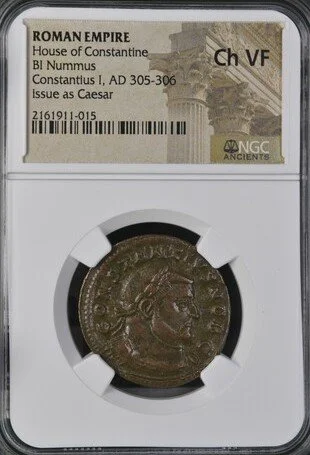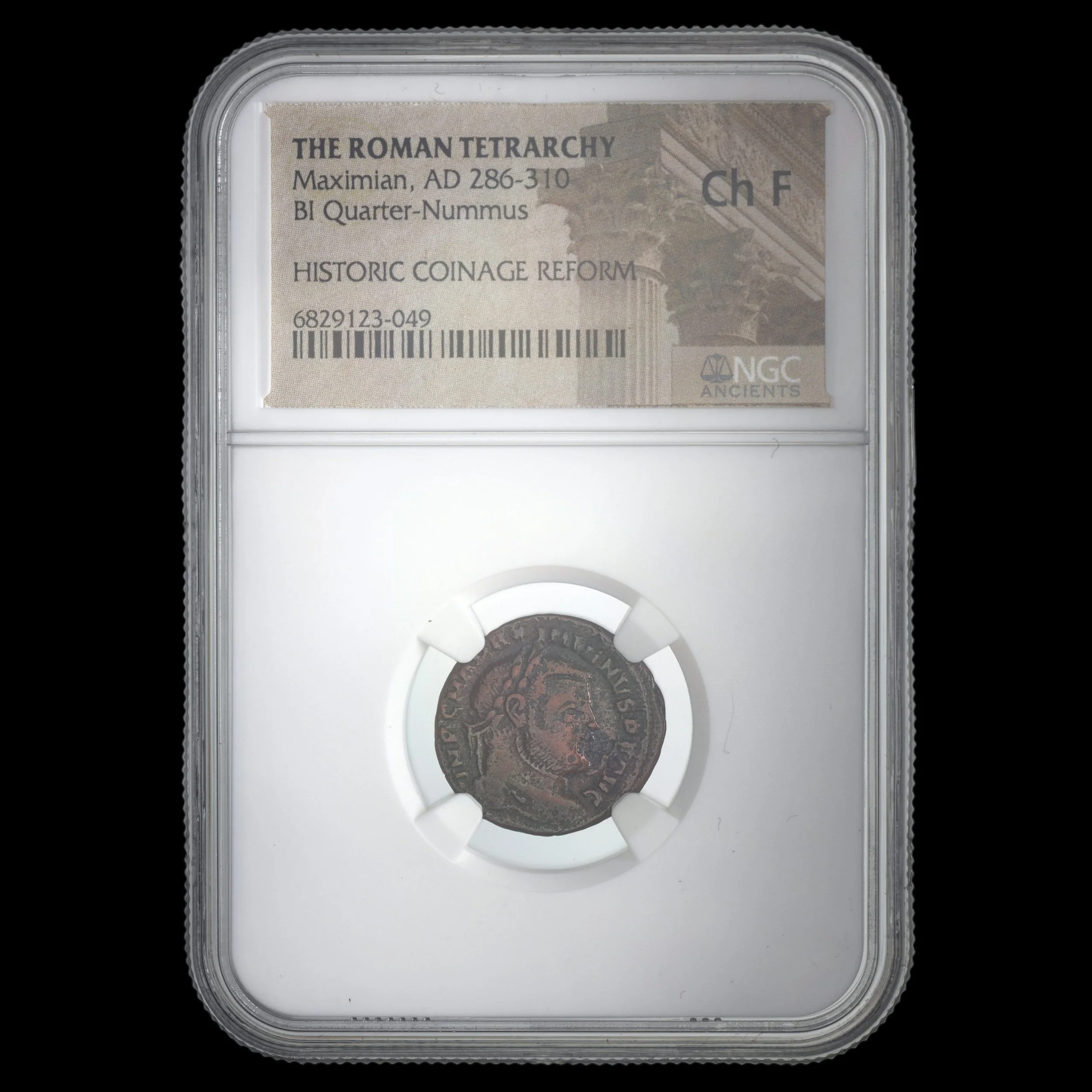 Image 1 of 6
Image 1 of 6

 Image 2 of 6
Image 2 of 6

 Image 3 of 6
Image 3 of 6

 Image 4 of 6
Image 4 of 6

 Image 5 of 6
Image 5 of 6

 Image 6 of 6
Image 6 of 6







Roman Bronze Coin of Emperor Constantius I Chlorus (about 1,715-1,730 years ago)
The coins shown are representative examples of the grade and type, but not the actual specimens for sale. For details on NGC’s grading standards and definitions, please refer to our NGC Grading page.
This large bronze coin depicts Constantius I, nicknamed "Chlorus" (the Pale), who served as Caesar and later Augustus in the western provinces during Diocletian's innovative Tetrarchy system. Father of Constantine the Great, Constantius represented a pivotal transitional figure between the Crisis of the Third Century and the Christian Roman Empire that would emerge under his more famous son.
Coin Description:
Front side: Portrait of Constantius I facing right, typically shown with short military haircut and either bearded or clean-shaven, with Latin inscription giving his name and titles
Back side: Likely depicts themes associated with the Tetrarchy such as military victories, Genius (guardian spirit) of the Roman People, or scenes related to imperial harmony and succession
Technical Details:
Bronze composition
Denomination: AE1 (modern classification indicating a large bronze coin)
NGC certified
Minted between 293-306 AD
Condition as certified by NGC
Historical Significance: Constantius Chlorus played a crucial role in the innovative Tetrarchy system devised by Emperor Diocletian to solve Rome's succession problems after decades of military anarchy. Appointed as Caesar (junior emperor) of the western provinces in 293 AD, Constantius successfully campaigned in Britain, recapturing territory lost to usurpers. When Diocletian and Maximian abdicated in 305 AD, Constantius was elevated to Augustus (senior emperor) of the West. Though he died in 306 AD at York (modern England) after only a year as Augustus, his greatest legacy came through his son Constantine, whom the troops proclaimed emperor upon Constantius' death, eventually leading to the collapse of the Tetrarchy system. Constantius also influenced religious history by reportedly being tolerant toward Christians, unlike his eastern colleagues who implemented the Great Persecution, potentially influencing his son's later embrace of Christianity.
The coins shown are representative examples of the grade and type, but not the actual specimens for sale. For details on NGC’s grading standards and definitions, please refer to our NGC Grading page.
This large bronze coin depicts Constantius I, nicknamed "Chlorus" (the Pale), who served as Caesar and later Augustus in the western provinces during Diocletian's innovative Tetrarchy system. Father of Constantine the Great, Constantius represented a pivotal transitional figure between the Crisis of the Third Century and the Christian Roman Empire that would emerge under his more famous son.
Coin Description:
Front side: Portrait of Constantius I facing right, typically shown with short military haircut and either bearded or clean-shaven, with Latin inscription giving his name and titles
Back side: Likely depicts themes associated with the Tetrarchy such as military victories, Genius (guardian spirit) of the Roman People, or scenes related to imperial harmony and succession
Technical Details:
Bronze composition
Denomination: AE1 (modern classification indicating a large bronze coin)
NGC certified
Minted between 293-306 AD
Condition as certified by NGC
Historical Significance: Constantius Chlorus played a crucial role in the innovative Tetrarchy system devised by Emperor Diocletian to solve Rome's succession problems after decades of military anarchy. Appointed as Caesar (junior emperor) of the western provinces in 293 AD, Constantius successfully campaigned in Britain, recapturing territory lost to usurpers. When Diocletian and Maximian abdicated in 305 AD, Constantius was elevated to Augustus (senior emperor) of the West. Though he died in 306 AD at York (modern England) after only a year as Augustus, his greatest legacy came through his son Constantine, whom the troops proclaimed emperor upon Constantius' death, eventually leading to the collapse of the Tetrarchy system. Constantius also influenced religious history by reportedly being tolerant toward Christians, unlike his eastern colleagues who implemented the Great Persecution, potentially influencing his son's later embrace of Christianity.






























